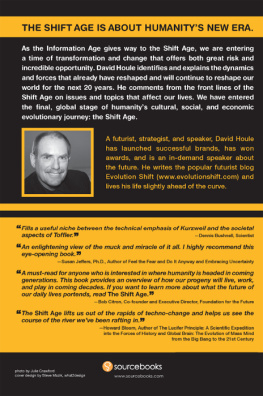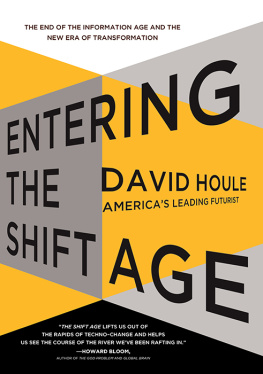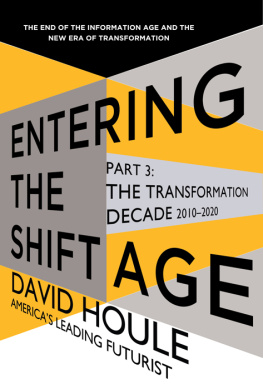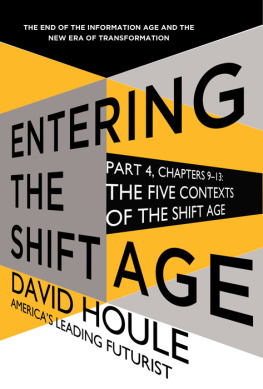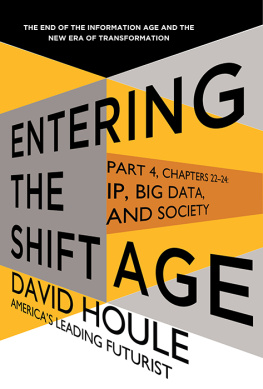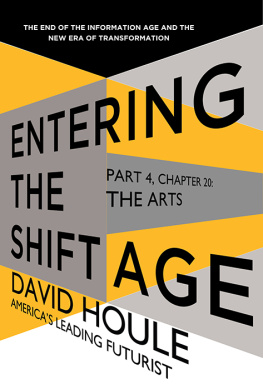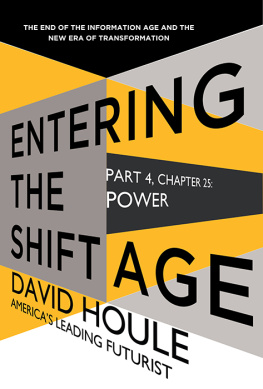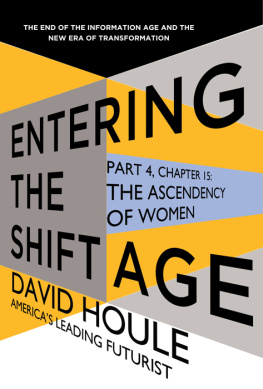
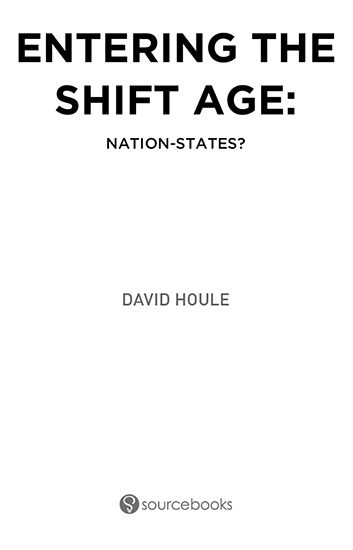
Copyright 2012 by David Houle
Cover and internal design 2012 by Sourcebooks, Inc.
Cover design by Studio Gearbox
Sourcebooks and the colophon are registered trademarks of Sourcebooks, Inc.
All rights reserved. No part of this book may be reproduced in any form or by any electronic or mechanical means including information storage and retrieval systemsexcept in the case of brief quotations embodied in critical articles or reviewswithout permission in writing from its publisher, Sourcebooks, Inc.
This publication is designed to provide accurate and authoritative information in regard to the subject matter covered. It is sold with the understanding that the publisher is not engaged in rendering legal, accounting, or other professional service. If legal advice or other expert assistance is required, the services of a competent professional person should be sought. From a Declaration of Principles Jointly Adopted by a Committee of the American Bar Association and a Committee of Publishers and Associations
All brand names and product names used in this book are trademarks, registered trademarks, or trade names of their respective holders. Sourcebooks, Inc., is not associated with any product or vendor in this book.
Published by Sourcebooks, Inc.
P.O. Box 4410, Naperville, Illinois 60567-4410
(630) 961-3900
Fax: (630) 961-2168
www.sourcebooks.com
CONTENTS
PART 4
THE FUTURE OF
THE SHIFT AGE
In Part Four, we will look at the future by first focusing on some large concepts and contexts of the Shift Age, followed by a close look at particular segments of society and humanity.
In Part Two, we looked at the three dominant forces of the Shift Age: the Flow to Global, the Flow to the Individual, and Accelerating Electronic Connectedness. These three forces are driving several big ideas that are initiating massive change now, and will have largely reshaped our world by the year 2025.
One clear difference between the Information Age and the Shift Age is content and context. The true clich of the Information Age was content is king. The reality of the Shift Age is context is king. Entering the Shift Age, we live in an increasingly contextual world. I have selected the five contexts I think have the greatest impact and influence.
THE FIVE MAJOR UNDERLYING CONTEXTS OF THE SHIFT AGE
1.The Earth Century
2.The need to retrofit the twentieth century
3.The Concept of Place has changed forever
4.The merging of biology and technology
5.The move toward an evolutionary shift in human consciousness
So now let us begin by taking a look at these five contexts, and then explore what much of society will look like in the years and decades ahead. Some of the areas we will explore the future about are Shift Age Generations, Education, Technology, Energy, Brands and Marketing, the future of the Nation-State, and Powerall areas that will have transformational change.
Its time to enter the Shift Age and our collective future.
CHAPTER TWENTY-SIX
NATION-STATES?
The Global Stage of Human Evolution
The global stage of human evolution is now beginning in the Shift Age. We have moved from family to tribe, village to city, city-state to nation-state, and our only remaining boundary for now is planetary. Of course, all of these human groupings will continue to exist, but they are no longer the only categories that define us and, more importantly, they no longer separate us. We are all, at varying speeds, becoming global citizens.
The Flow to Global is the force at play here. This force started with the beginning of the global economy at the end of the Cold War. In the last twenty years, this global economy has fully taken root and completely recast economics in a worldwide orientation. Chapter Three pointed out that economics is usually the first driver of human endeavor and that culture and politics follow closely behind. This means that as of 2012 the word is no longer only an economic termit is the term that describes what will happen to culture and politics and almost all aspects of human society for the next twenty years.
This global stage of human evolution is a big concept, and one that may not be readily apparent to the vast majority of humans alive today. It is very hard to be an American Baby Boomer who grew up in the city where you still live and think of yourself as a global citizen. You are emotionally connected to your family, your neighborhood, your city or suburb, and perhaps the sports teams and cultural institutions in your area. You may leave this primary geographical and cultural orientation to do some international travel. Perhaps you work for a company that is a multinational or work in a field that has a lot of international customers or partners. This means that you are aware of the global economy but might be too place-based to see it, other than its manifestations in a changed local economic landscape.
The leading-edge people who feel they are at least partly global citizens are often people who have traveled extensively around the globe, visit or live in multiple places over time, have constant personal and business interactions with people from many countries, and have constant awareness of multiple time zones. Another category of people who have a sense of being global citizens are those who see the world through the filters of the Earth Century or Spaceship Earth. These people realize that we all have to be crew and work together in that regard. A third grouping are those who sense that a new consciousness, a new dawn of human awareness, is indeed approaching.
I am an American and proud of it. I live in both Chicago and Sarasota and am attached to both places. I vote in Chicago and have an Illinois drivers license. I am concerned about the future of my country. I have spoken on all six inhabited continents in the last two years. I have subscribers to my blog and newsletters from dozens of countries. So I am from one place and I have a place where I live, yet every day I feel ever more a global citizen. I am increasingly aware of moving into the global stage of human evolution. True, we all have legacy thoughts and an increasingly out-of-date sense of place, but those come from contexts of our past. But the overall direction is clear: Our future is ever more globally oriented.
The Nation-State
Countries, nations, and empires have existed throughout the last few millennia. Based upon geography, ethnicities, languages, and religions, these larger groupings of humans are the building blocks of human history. However, the nation-state as we know it today was largely formed during the Industrial Age. During this age, the nation-state reached its zenith. This two-hundred-year period is winding down and giving way to the new global age.
This does not mean that the nation-state will go away. It is just that the concept and purpose of it are in a real process of change. As numbers of countries experience the same issues and problemsfinancial interconnectedness, climate change, environmental degradation, vast amounts of capital flowing around the world at the speed of light, corporations that operate in dozens of countries, scarcity of adequate water and foodcommonality becomes clearer through time.
Global problems can only be solved by global solutions. No single nation-state or even a number of nation-states can solve global problems by themselves.


